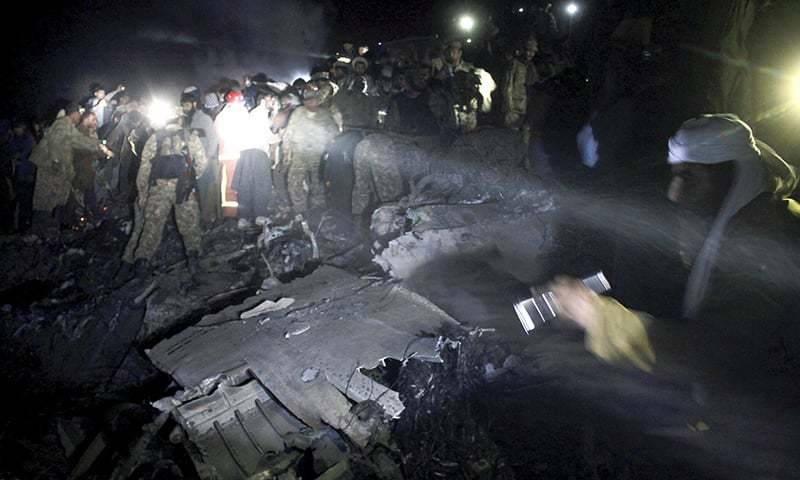The nation is mourning the demise of the precious lives on board PIA flight PK-661 which crashed near Havelian on its scheduled flight from Chitral to Islamabad a few hours ago. Meanwhile, television channels are giving exclusive coverage in their prime time hours to the unfortunate incident neglecting one key journalistic principle: ethics.
According to a book called The Plane Truth, during the second week of July 1996, 842 people died in various road accidents in US alone. In that same week, Trans World Airline flight 800 exploded right after take-off from JFK International Airport, killing all 230 people on board. Yet the air crash, and not the highway deaths, became the most covered news story of the year.
In today’s unfortunate incident, 48 people including members of the crew have lost their lives. But what is disappointing is the quality of news coverage from Pakistani media organizations, because journalists and field reporters lack basic credentials to report on an air crash, or similar disasters. This requires extensive scientific and engineering information.
How many times we have we heard from reporters since the PK-661 crash that “this information is not verified, but according to sources this is the reason behind the crash”.
I just want to ask what those sources are. And even if there are actual sources, why is the information still unverified? Lastly, maybe we should appreciate the media’s effort in managing to find a reason behind the crash even before a qualified expert has visited the crash site.
Journalists should remember that in case of any air crash, there is never a single cause. It is a chain of events that leads toward the main reason, which cannot be determined within hours of any crash. Such journalistic approach is never acceptable in developed countries.
As part of my ongoing MS thesis titled Analysis of Air Crash News Reporting in Pakistan at National University of Sciences and Technology (NUST), I have carefully studied news reports of three commercial air crashes of Pakistan, (PIA Multan Fokker crash, Air Blue Margalla Hills, Bhoja Air Islamabad). News reports of the accidents are collected from the most widely read newspapers of Pakistan. The coverage of the first 15 days of a crash from these newspapers is analyzed, and according to the initial findings, it is hard to believe that there is hardly any follow-up coverage after the fourth or fifth day.
Coming back to today’s incident, the biggest disappointment remains the fact that television channels invite so-called 'experts’ in their live transmission. These experts paint a completely new picture in front of the public, raising many questions and doubts. The fact is that the credibility of those experts always remains questionable and a person who directly belongs to the aviation field can judge how factual the knowledge is and how it is manipulated using various news frames.
Another element in disaster reporting which should be highlighted is the extensive reliance on eyewitness accounts, as eyewitnesses are among the first group of people who reach the accident site. According to an independent study conducted in 2014 titled Reliability of Eyewitness Reports to a Major Aviation Accident, using statements of 354 eyewitnesses to the American Airlines Flight 587 crash, it was found out that majority of eyewitness accounts proved to be wrong at the end. Now one can imagine, with so many different eyewitness accounts, the eventual quality of news reports.
It is pertinent to mention that according to National Aviation Policy of Civil Aviation Authority Pakistan 2015, around 58.1 million jobs are supported by aviation sector around the world and the global economic impact of aviation is 2.4 trillion dollars. It is estimated that around 500,000 people travel by air at any given moment. These statements prove the importance of this sector in the 21st century; but it is unfortunate that this professional sector remains neglected in Pakistan. In this era of globalization and technology, where various credible sources of information are available for a journalist, the repetitive mistakes related to science and engineering, ignoring journalistic ethics, asking absurd questions, point-scoring and giving conclusions within hours of the incident, is never justified at any level.
The best solution to this whole problem is to learn. Journalists are human beings, who can make mistakes. Therefore, it is the duty of Civil Aviation Authority, Pakistan International Airline and other aviation bodies to regularly conduct training sessions for the journalists, so that basic and major mistakes can be avoided in the future.
On the other hand, the regulatory authorities should ensure a transparent investigation of accidents in order to avoid similar disasters in the future.
It is high time to work on this suggestion, as this will not only raise the bar of aviation reporting in Pakistan, but would also create new job opportunities in the market. If ignored, the result would be the same as Khalil Jibran famously said, 'We live from one tragedy to another, we mourn and move on, we only raise our voices in funerals. This is our pattern , this is what we are.'






